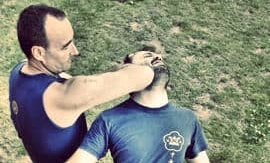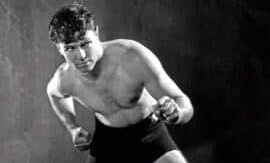
SIFU NIC “MOY WU TUNG SHAN” BARTELL IS A 12TH GENERATION VING TSUN DISCIPLE. HE IS A DIRECT STUDENT OF SIFU AARON “MOY 10 TUNG” VYVIAL AND GRAND-STUDENT OF GRANDMASTER ANTHONY “MOY TUNG” DANDRIDGE. SIFU BARTELL HAS SCHOOLS IN HOUSTON AND GEORGETOWN TEXAS.
Tell us a little bit about the core principles of Ving Tsun and their origins?
I could list off a bunch of things like centreline, balance, simultaneous attack and defence, etc. but I think that would miss the most important principle, which concerns self-control. I don’t mean inhibiting yourself from doing things, but rather learning how not to allow your environment to control you and learning how to control your environment including yourself.
The most core principle is not letting external factors change your course. So, if you want to accomplish something, then the most Ving Tsun thing to do is to move towards it and if you don’t want to participate in something, then the best Ving Tsun is not to allow any outside force to cause you to have to participate in something that you don’t want to. Ving Tsun is about freedom—you do what you want, and nobody can cause you to do something you don’t want. When you feel that way, when you don’t feel forced to do things or when you’re able to do what you see fit, then you can be relaxed and free. So good Ving Tsun is the pursuit of that ability.
What are the key techniques of the system?
The key techniques are encoded within Siu Nim Tao. So, what’s Siu Nim Tao about? The study of that question is the greatest technique. Within Siu Nim Tao, it’s all there. If you study the form thoroughly, then you will develop good Kung Fu. New students are often ready to learn it and move on, but those who have been around for a while understand the depth of its purpose. I have a great appreciation for my Sifu Aaron Vyvial and my Sigung Moy Tung for encouraging my students and me to continue the study of the form. Without their hard work and guidance, I definitely would’ve missed this vital detail.
How’s the core Ving Tsun principles and techniques best taught?
The best way for them to be taught is not by your Sifu teaching you directly, but instead, it’s when your Sifu exposes you to the system and creates an environment where the focus is pure Ving Tsun. When that’s provided, the Ving Tsun can reveal itself. A Sifu’s job is to make sure that students aren’t talking too much, to make sure that students stay focused on their own Kung Fu so they can learn and develop their understanding of Ving Tsun. The core principles and techniques are taught best through hands-on practice, not a theoretical debate; a good Sifu ensures that as much as possible the conversation in the classroom is done with the hands. That’s Kuen Kuit. This is an emphasis in our Kung Fu family, and once again, I’m thankful to my Sifu for showing me the way and my Sigung for doing the work to grow such a strong Kung Fu family.
What else do you gain from the study of Ving Tsun?
Let there be no mistake, Ving Tsun develops deadly force; the training is 100% about weaponising the human body, but that ability affects every part of us. Serious students do better at work, they do better with their families, and they become more effective. They hold themselves differently; the way they walk changes. A lot of students are so worried about, “Will I be able to defend myself?” and “Will this style make me a better fighter than someone else?” and all this kind of stuff.
The funny thing is that Ving Tsun is potent and you get so much out of it in such a short while. Before you know it, you’re not even worried about fighting anymore because you know your technique works; you can feel it, and you know you have enough. People mess with you, and a little something accidentally comes out that looks like nothing. The next thing you know they’re freaking out asking you, “How did you do that?” so you know that it’s the real thing, it comes out on its own.
It’s interesting that students often come in with this mentality, myself included, of wanting to be the best fighter, etc. Instead of even thinking about those things they end up with a relaxed mentality, powerful observation, fortitude, a profound ability to do what is efficient, and the ability to develop a connection with people and move forward with the things they want to do. When you have all those things, the fighting becomes almost immaterial. Some guy confronts you, and you don’t even want to fight him because you’re thinking, “What’s the point of this?” I already know I can knock your teeth out and I don’t feel like having to talk to the police tonight, just leave me alone.
Suddenly, the ego component and the nervousness of what’s about to happen isn’t on your mind. You’ve got so much Kung Fu, you’ve been hit thousands of times in class, you know it doesn’t even matter if this guy hits you, so why participate in this event? It’s a whole mind shift that changes how you deal with things. When your boss is coming at you or a family member is yelling at you, you have a whole new level of relaxation and the ability to stay calm and ensure you stay on track.
If you know where you want to go and somebody’s in the way, then Ving Tsun teaches you to deal with it effectively. The system doesn’t teach you to create a fight when there isn’t one and it doesn’t teach you to avoid a fight when there is one. It teaches you to move forward and so when you have that it touches every bit of what you do.
With the popularity of MMA, why do you believe we don’t see traditional Ving Tsun represented in sports-combat entertainment?
People ask this frequently and it misses the truth of the matter. Ving Tsun is represented—it’s the spark that started the flame that turned into the worldwide phenomena of MMA today. Most of the industry has been influenced by the teachings, philosophies, and writings of Bruce Lee. Lee’s philosophies were deeply impacted by his Sifu, Ip Man, and the Ving Tsun system. The mere presence of the industry itself results from the impact of Ving Tsun. Many styles have adopted techniques and philosophies from the Ving Tsun system, and in the ring, those techniques can be seen to this day, albeit not in the purest or most potent form.
The mainstream population can’t see it, but if you look closely, you will see several concepts being applied. What’s not represented by the media is the source; the words Ving Tsun are not seen even when the principles are. The system could be represented better if the media gave credit where credit is due, but let’s face it that doesn’t even happen correctly a lot of the time in the Ving Tsun world either.



















